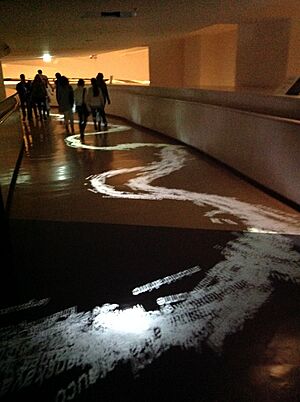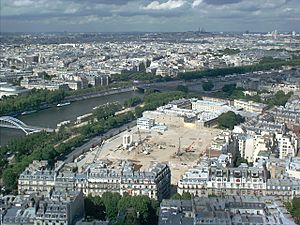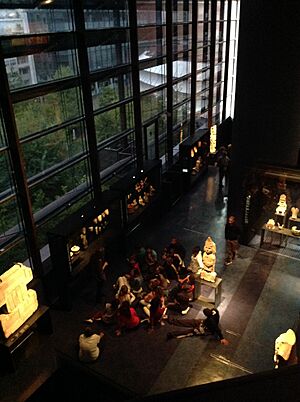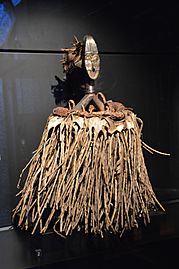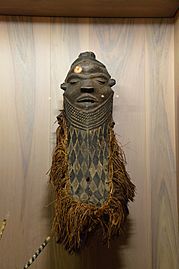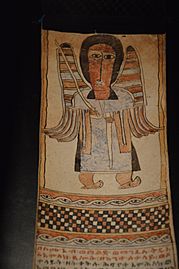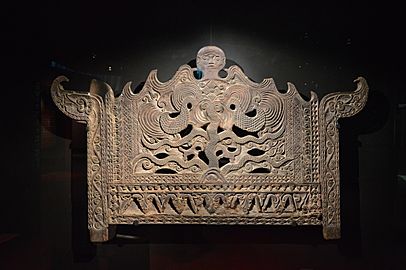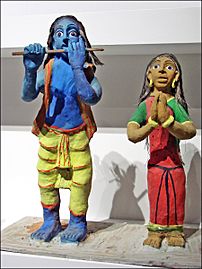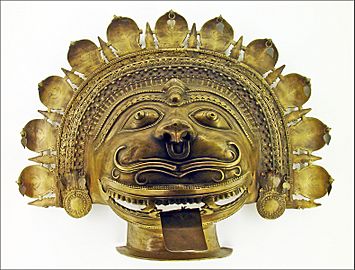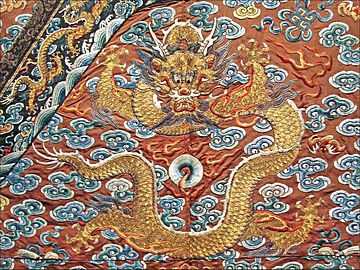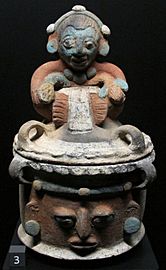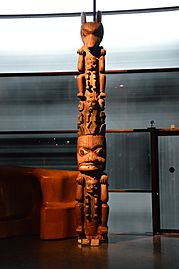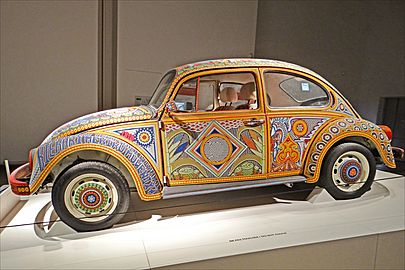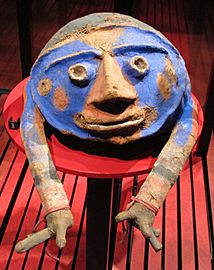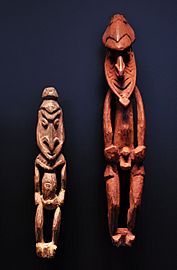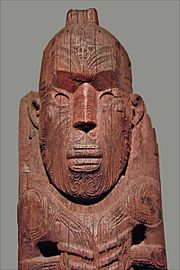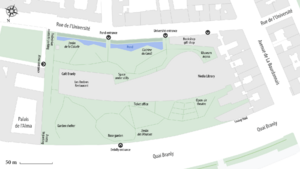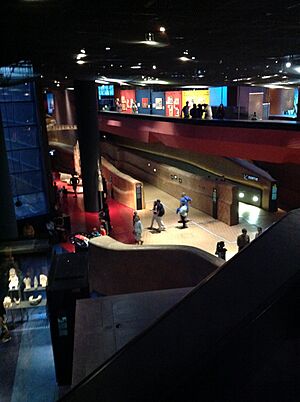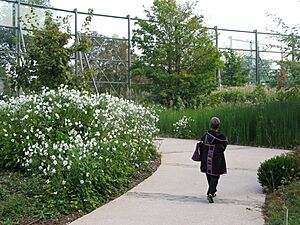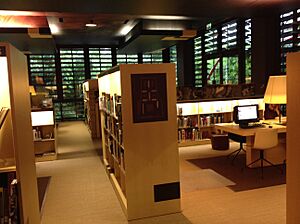Musée du Quai Branly – Jacques Chirac facts for kids
The Musée du Quai Branly – Jacques Chirac is a famous museum in Paris, France. It was designed by the French architect Jean Nouvel. This museum shows amazing art and cultures from Africa, Asia, Oceania, and the Americas.
The museum has over a million items in its collection. These include art, photos, and important documents. About 3,500 objects are on display at any time. You can see them in both permanent and special changing exhibits. Some items from the museum are also shown at the Louvre Museum.
The Quai Branly Museum first opened in 2006. It is one of the newer big museums in Paris. In 2016, over 1.1 million people visited it. The museum is managed by two French government groups. It is a place for both showing art and for doing research. You can find the museum near the Eiffel Tower in Paris, right by the Seine River.
Contents
History of the Museum
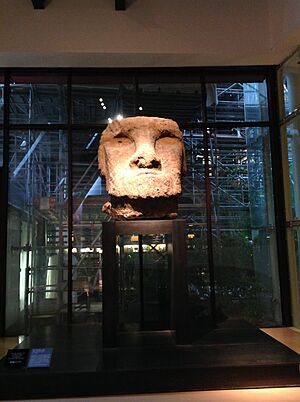
French presidents often create new museums. This is a way to leave a mark during their time in office. President Jacques Chirac wanted a new museum to celebrate arts from around the world. This included art from the Americas, Africa, Asia, and Oceania.
For a long time, many French thinkers wanted a big museum in Paris. They wanted it to show the arts and cultures of people from colonized lands. These collections came from French explorers and scientists. In 1990, an art collector named Jacques Kerchache wrote an important article. He called for a museum that would show these "masterpieces of the entire world."
Jacques Chirac, who was then the Mayor of Paris, liked this idea. When he became president in 1995, he decided to create the new museum. It would combine collections from two older museums:
- The National Museum of the Arts of Africa and Oceania (MAAO). This museum had about 25,000 objects.
- The Museum of Man (Musée de l'Homme). This museum had about 250,000 objects.
The new museum was officially started in December 1998. Stéphane Martin became its first president. The museum also bought 10,000 new objects to add to its collections.
The museum was built on the banks of the Seine River. This spot is close to the Eiffel Tower. In 1999, a competition was held to choose an architect. Jean Nouvel won the competition. He designed the museum to blend in with its surroundings. The main building looks lower than other buildings. It is also hidden by beautiful gardens.
Nouvel wanted the museum to feel open and welcoming. He designed the inside so that visitors could move easily between different areas. There are no walls separating the four main parts of the world. This lets visitors feel like they are traveling from one continent to another. The museum opened to the public on June 23, 2006.
Museum Name
The museum first opened as the Musée du quai Branly. This name came from the street it is on, which is named after a scientist, Édouard Branly. People had suggested other names, but this one was chosen to avoid arguments. In June 2016, "Jacques Chirac" was added to the museum's name. This honored the president who started the project.
What You Can See
The museum has a huge collection of items. These include:
- 300,000 art pieces
- 700,000 photographs
- 320,000 documents
- 10,000 musical instruments
- 25,000 pieces of clothing or textiles
About 3,500 objects are always on display in the main area. About 500 of these are changed each year. The museum has both permanent exhibits and big temporary exhibits that change every six months. You can see masks, special cloths, costumes, and musical instruments.
Past temporary exhibits have covered many topics. For example, there was an exhibit about the history of tattoos. Another showed propaganda posters from Vietnam. There was also an exhibit called "Tiki Pop." This showed how the culture of Oceania influenced American pop culture in the 20th century. It included films, music, and even a recreated "tiki bar."
The museum also has special collections. These include objects from the French colonization of North America. There are also items showing the role of women travelers in the 18th and 19th centuries. You can also see paintings by Aboriginal Australians on eucalyptus tree bark. A small part of the museum's collection is also shown at the Louvre Museum.
Returning Cultural Items
In 2018, the museum was part of a big discussion. This was about returning objects that were taken from former French colonies. These items were often acquired during the time of colonial conquest.
French President Emmanuel Macron asked two experts to study this issue. They suggested that items taken unfairly during the colonial period should be returned. This would happen if the original country asked for them. The Quai Branly Museum holds about 70,000 sub-Saharan African items. Many of these are in storage or on display.
After this report, President Macron promised to send 26 items back to Benin. These items were taken during a war from what is now Benin. This was a big change from France's past policy. Before, France said its national collections could not be given away. This discussion has encouraged museums around the world to work with African institutions. They are looking at how to return cultural heritage that was taken unfairly.
Selected Objects from the Collections
African Collection
-
A reliquary from the Sango people of Gabon (19th century)
-
Mask from the Pende people of Congo (20th century)
-
Mask from Eket people, Nigeria (20th century)
-
Guardian angel, Ethiopia (19th century)
Asian Collection
-
Figurines by Sundaribai from Surguja district in Chhattisgarh, India (20th century)
-
Ritual mask from India (20th century)
Americas Collection
-
Mayan container from Guatemala, AD 600–800
-
Aztec image of Chicomecoatl, goddess of corn
-
A heraldic mast, or totem pole, from the Nisga'a people in British Columbia, Canada (1890)
Oceania Collection
-
A mask from Vanuatu, from the south of the island of Malekula. (20th century)
-
Carved wooden figurines from Papua New Guinea (20th century)
-
Māori sculpture from New Zealand (1850)
-
Statue from Polynesia (1760–1860).
Museum Buildings
The museum has four main buildings and a large garden. The whole complex cost 233 million euros to build.
- The main building is where the art galleries are. It is 210 meters long and has a huge terrace on the roof. This building is built like a bridge, 10 meters above the garden. It is supported by strong concrete and steel columns. As the garden trees grow, they will hide the columns, making the building look like it's floating on treetops.
Visitors enter the main building and walk up a gentle, winding ramp. This leads to the main gallery, which is 200 meters long. The gallery is kept a bit dark, with light mostly on the art pieces. There are 30 different smaller galleries on the north side. These look like colorful boxes from the outside. Three upper levels (mezzanines) look down on the main gallery. One is for multimedia, and the other two are for temporary exhibits. The side of the building facing the garden has an auditorium, classrooms, and a bookshop.
- The separate Branly building holds the museum's offices. It has a special "green wall" on its north side, facing the Seine River. This wall is covered in living plants.
- The Auvent building is connected to the Branly building by walkways. It has more offices and a lecture hall. It also stores 700,000 photos and sound recordings.
- The building on the Rue de l'Université has the museum's workshops and library. Its ceilings and outside walls are decorated with art by eight Indigenous Australian artists.
Gardens of the Museum
The museum's gardens are very special. They were designed by landscape architect Gilles Clément. Instead of a traditional French garden with straight paths, these gardens are like a beautiful tapestry. They have winding paths, small streams, hills, and pools. They use plants native to France and others that grow well in Paris. When the museum first opened, 169 trees and 72,000 plants were planted.
On the north side, a tall glass wall protects the garden from street noise. The gardens on this side almost hide the museum building. The paths wind through the gardens, making it feel like an adventure.
Another amazing part of the garden is the "green wall." This living wall of plants covers 800 square meters of the museum's outside walls. It also covers 150 square meters inside. It has 15,000 plants from 150 different types, from places like Japan, China, and the Americas.
Museum Library
The museum has a library with three main parts:
- A collection of books, with two reading rooms. One is for research, and one is for general reading.
- A collection of pictures, including photographs and drawings.
- An archive collection of historical documents.
You can also find many scientific journals, databases, and other materials online through the library. The library also holds special collections from important ethnologists and art collectors.
See also
 In Spanish: Museo del muelle Branly - Jacques Chirac para niños
In Spanish: Museo del muelle Branly - Jacques Chirac para niños




